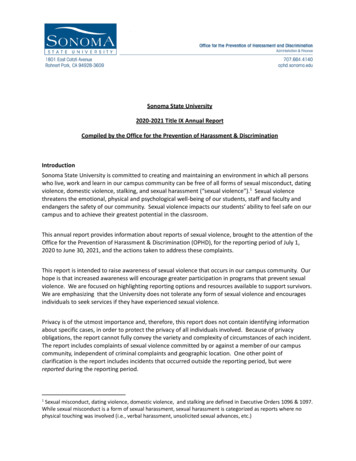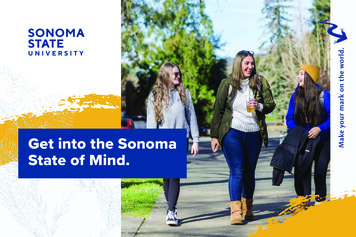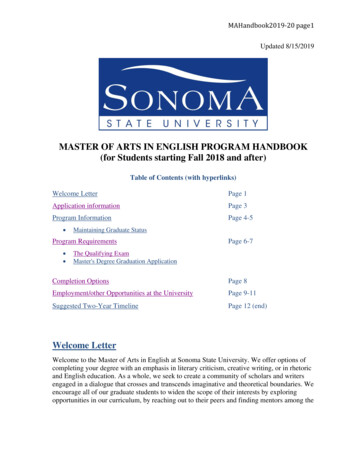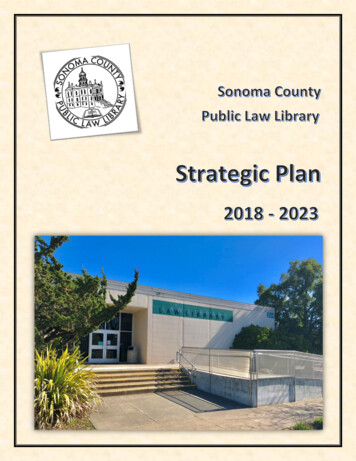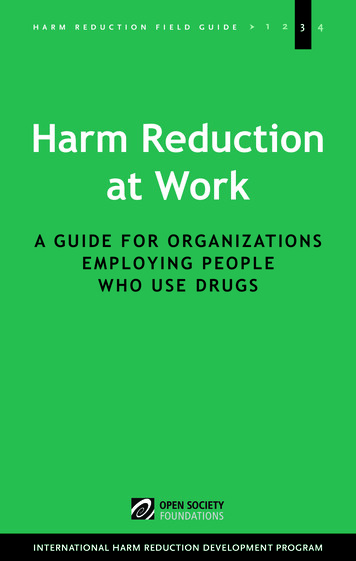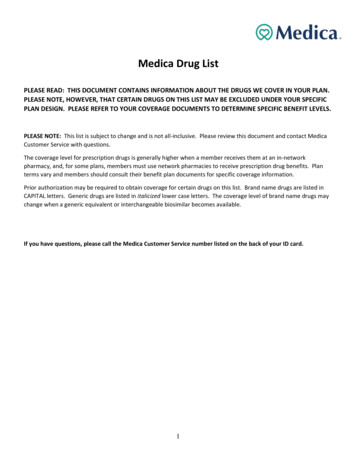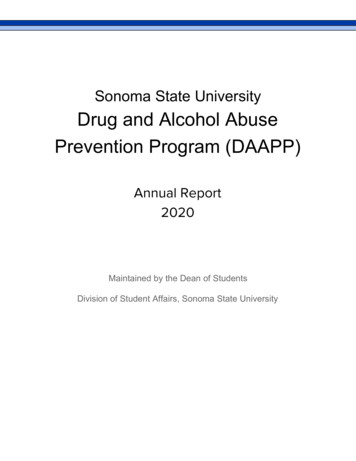
Transcription
Sonoma State UniversityDrug and Alcohol AbusePrevention Program (DAAPP)Annual Report2020Maintained by the Dean of StudentsDivision of Student Affairs, Sonoma State University
Table of ContentsSonoma State University Drug Abuse and Alcohol Prevention Program (DAAPP)Statement3Annual Notification to Students and Employees4Standards of Conduct5StudentsFaculty and Staff55Health Risks7Alcohol7Alcohol-Related Short-Term Health Risks7Alcohol-Related Long-Term Health Risks8Health Risks for Illicit Drug UseTHC and other cannabinoidsCocaine (crack and other stimulants)Hallucinogens (LSD, mescaline, psilocybin)Heroin (other opioids)Tobacco (cigarettes, chew, and other products)Programs and ResourcesUniversity Programs and Resources for StudentsThe Alcohol and Other Drugs (AOD) CommitteeAlcohol and Other Drugs Education & Prevention Specialist (AODEPS)Student Health Center (SHC)Counseling and Psychological Services (CAPS)899999101010101111University Programs and Resources for Employees11Human Resources Employee Assistance ProgramLocal Community Resources1112Adult Children of AlcoholicsAl-Anon (Alateen)Al-Anon (Alateen)-Sonoma CountyAlcoholics AnonymousAlcoholic Anonymous Intergroup Fellowship Office (Sonoma County)Anthem Blue CrossCocaine AnonymousCocaine Anonymous (Sonoma County)County Department of Health ServicesDrug Abuse Alternatives Center (DAAC)Drug Enforcement Administration1212121313131414141415Sonoma State University Drug Abuse and Alcohol Prevention Program Report 2020 Page 1
Drug Enforcement Administration Resource: Campus Drug PreventionFamily Anonymous Drug AbuseKaiserMarijuana AnonymousNarcotics AnonymousNational Council on Alcohol and Drug DependencyPetaluma People Services (Counseling and Prevention Services)Santa Rosa Treatment Program, Inc.1516161617171718Statement about Disciplinary Sanctions19University Policies and Regulations20Sonoma State University Alcoholic Beverages Policy No. 1985-1Sonoma State University Drug-Free Workplace Policy No. 1989-1Smoking and Tobacco-Free PolicyStudent ConductOn-Campus HousingSSU EmployeesCalifornia LawControlled SubstancesAlcoholDriving Under the Influence20202121212223232324Federal Law24Biennial Review26Appendix A. Annual Notification Letter to Students28Appendix B. Annual Notification Letter to Employees29Sonoma State University Drug Abuse and Alcohol Prevention Program Report 2020 Page 2
Sonoma State University Drug Abuse and AlcoholPrevention Program (DAAPP) StatementSonoma State University is committed to providing a safe, healthy and supportive learningenvironment for students and employees. The university takes seriously and understands itsobligation to inform the campus community of available resources and support, as well as theeducational, disciplinary, health, and legal consequences of abuse of alcohol and illegal druguse, not only for the benefit of the Sonoma State University community butin compliance withrelevant federal and state law. Sonoma State University’s Drug and Alcohol Abuse PreventivePrograms (DAAPP) are intended to support student and employee health, safety and securityby increasing awareness, preventing abuse, and decreasing potential drug and alcohol relatedcrime.Sonoma State University strives to maintain communities and workplaces free from the illegaluse, possession or distribution of alcohol and controlled substances. The use, possession,manufacture, or distribution of illegal drugs and drug-related paraphernalia, (except as expresslypermitted by law and University regulations) or the misuse of legal pharmaceutical drugs isprohibited. Similarly, the use, possession, manufacture, or distribution of alcoholic beverages(except as expressly permitted by law and University regulations), or public intoxication while oncampus or at a University related activity is prohibited.SSUs comprehensive approach to addressing the use, misuse, and/or abuse of alcohol andother drugs emphasizes: Taking effective steps to create and maintain a drug-free workplace and educationalenvironment for students, faculty, and staff.Providing continuous access to medical and behavioral healthcare services, along withreferrals to off-campus treatment facilities as appropriate.Engaging in a health promotion process that includes prevention, the development ofpersonal skills, and systemic environmental management.Encouraging individuals who are diagnosed with at-risk substance abuse disorder or areotherwise experiencing problems associated with alcohol and other drugs to seekassessment and treatment.Engaging in ongoing self-assessment of university sanctions for the illegal manufacture,distribution, use or possession of drugs, and the unlawful possession or use of alcohol.Sonoma State University Drug Abuse and Alcohol Prevention Program Report 2020 Page 3
Annual Notification to Students and EmployeesUnder the Drug-Free Schools and Communities Act Amendment of 1989, Sonoma StateUniversity is required to annually distribute its drug abuse and alcohol prevention program tofaculty, staff and students. These requirements exist as a condition of receiving funds or anyother form of financial assistance under any Federal program. The annual notification includes:1. Standards of conduct that clearly prohibit, at a minimum, the unlawful possession, use,or distribution of illicit drugs and alcohol by students and employees.2. A list of applicable legal sanctions under federal, state and local laws for the unlawfulpossession or distribution of illicit drugs and alcohol.3. A description of the health risks associated with the abuse of alcohol or use of illicitdrugs.4. A list of drug and alcohol programs that are available to employees and students.5. A clear statement that the institution of higher education will impose disciplinarysanctions, up to and including expulsion or termination of employment and referral forprosecution.The Drug and Alcohol Abuse Prevention Programs (DAAPP) Annual Notification (Appendix Aand B) is distributed via University email to all students and employees once every semester,including Fall, Spring, and Summer terms. This ensures that each student and employeereceives the notification as they join the campus community.The most recent DAAPP notification is also available for review online at The Division ofStudent Affairs . SSU’s campus community expects that all members abide by local, state andfederal laws, including the D rug Free Schools and Campuses Regulations ( DFSCR), regardingalcohol and other drugs as well as the California State University (CSU) System Policyregarding Drugs and Alcohol. The System Policies include Executive Order 1098 that describesstandards of conduct that clearly prohibit the unlawful possession, use, or distribution of illicitdrugs and alcohol by students and employees on University property or as part of any ofUniversity sponsored activities.The DAAPP annual report is maintained by the Dean of Student (DOS), within the Division ofStudent Affairs at SSU. The document is housed on the Sonoma State University Division ofStudent Affairs website.The Dean of Students and the Associate Vice President for Human Resources shall serve asthe main contacts that will have oversight responsibility of the DAAPP including, but not limitedto: updates, coordination of information required in the DAAPP, and coordination of the annualnotification to employees and students and the biennial review.Sonoma State University Drug Abuse and Alcohol Prevention Program Report 2020 Page 4
Standards of ConductStudentsSonoma State University is a student-centered institution offering a broad array ofacademic programs to engage students in diverse learning environments that educatethem to think critically and to expand their intellectual horizons while attaining theknowledge and skills necessary for responsible citizenship and productive careers. Tomaintain high standards, the University must furnish an atmosphere conducive to studyand educational growth, as well as one that enables and assists students in developingin a positive manner. University rules and regulations form parameters for individualbehavior on and off campus, and follow the normative standards of behavior adhered toby the City of Rohnert Park and Sonoma State University communities. By virtue ofenrollment at Sonoma State University, each student consents to follow the policies andprocedures of the university, including those outlined in this Code of Student Conduct. Itis the individual student’s responsibility to be familiar with all applicable conduct-relatedpolicies. A student may access all the University policies online at: University Policies .The Office of Student Conduct is responsible for the adjudication of cases involvingstudents and student organizations accused of violating campus rules, regulations, orpolicies; federal or state laws; and/or municipality ordinances. The University’s Office ofStudent Conduct’s purpose is to ensure the fair administration of the student conductprocess while supporting a safe and inclusive educational environment for all students.Through this process, our goal is to educate students about their rights andresponsibilities as well as provide feedback about behaviors that affect both themselvesand the campus community . The Student Conduct process is not a legal process and isseparate from federal, state, and local court proceedings. Instead, the standard ofresponsibility is based on a preponderance of evidence. The student conduct process isexpected to: Determine responsibility for behaviors that violate university rules, policies, andfederal, state, and local laws or ordinances Offer outcomes to assist students in learning about the impact of their actions onthemselves and others within their respective communities Protect the integrity of students, faculty, staff, the institution, and the UniversitycommunityFaculty and StaffSonoma State University Drug Abuse and Alcohol Prevention Program Report 2020 Page 5
Sonoma State University is committed to providing a safe, healthy, and productive work andacademic environment for all members of our campus. Consistent with our concern for thewell-being of faculty, staff and students, it is the policy of the University to maintain a work andacademic environment free from drug and alcohol abuse. Employees must remain free from theinfluence of controlled substances or alcohol while on duty. The unlawful manufacture,distribution, dispensation, possession, sale, offer to sell, offer to purchase and/or unlawful use ofcontrolled substances or alcohol on campus, or as any part of University-related activities, isprohibited. Controlled substances include, but are not limited to, cannabis, heroin, cocaine,LSD, and amphetamines.As a condition of employment, all California State University (CSU) employees (faculty, staff andstudent employees) must comply with the CSU Drug-Free Workplace Policy . The SonomaState University Drug-Free Workplace Policy is available at SSU Drug-Free Workplace .All University students, faculty members, and staff are subject to local state and federal lawsregarding the unlawful possession, distribution, or use of alcohol and illegal drugs. Violators aresubject to University discipline, criminal prosecution and/or removal from University housing.The unlawful manufacture, distribution, dispensing, possession or use of illegal drugs on theUniversity campus or at any University-sponsored event off-campus is also prohibited.Sonoma State University Drug Abuse and Alcohol Prevention Program Report 2020 Page 6
Health RisksImproper use of drugs or alcohol can seriously injure the health of employees andstudents, impair the performance of their responsibilities and endanger the safety andwell-being of fellow employees, students and members of the general public. Manywell-documented risks are associated with alcohol and other drugs, affecting not onlythe individual user but also the user’s family, friends and communities. Alcohol isfrequently implicated in cases of sexual misconduct on campus, and the misuse of otherdrugs is sometimes a factor in other violent behavior. Problems associated with alcoholand other drugs include impaired brain function; poor academic or job performance;relationship difficulties, including sexual dysfunction; a tendency toward verbal andphysical violence; financial distress; injuries or accidents; violations of the law such asdriving under the influence; willfully destroying property; and death.AlcoholFor men, at-risk alcohol consumption is drinking more than four standard doses (ordrinks) of alcohol a day and/or more than 14 drinks per week. For women, at-riskdrinking is drinking more than three standard doses (or drinks) drinks a day and/or morethan seven drinks a week. (One drink is equal to 12 oz. beer, 5 oz. wine, or 1.5 oz.liquor.) While any alcohol use has the potential to contribute to problems (e.g., alcoholuse impairs brain function and motor skills even when not legally drunk), studies showthat certain “at-risk” drinking patterns are associated with an increased likelihood ofnegative outcomes.At-risk drinking can cause poor performance in school or at work, accidents, injuries,arguments, legal problems (including DUI), strained relationships, undesirable or evendangerous sex, and verbal or physical violence, including the perpetration of sexualassault. At-risk and other risky patterns of alcohol consumption also contribute to sleepproblems, prolonged intoxication aka hangovers, cancer, liver disease, stroke,depression, anxiety, Alcohol Use Disorder and Alcohol Dependence.Alcohol consumption is involved in the majority of violent acts on campuses, includingsexual assault, vandalism, fights, and accidents involving cars, pedestrians andbicycles.Alcohol-Related Short-Term Health RisksExcessive alcohol use has immediate effects that increase the risk of many harmfulhealth conditions. There are most often the result of binge drinking and include thefollowing:Sonoma State University Drug Abuse and Alcohol Prevention Program Report 2020 Page 7
Injuries, such as motor vehicle crashes, falls, drownings, and burns Violence, including homicide, suicide, sexual assault, and intimate partnerviolence. Risky sexual behaviors, including unprotected sex or sex with multiple partners.These behaviors can result in unintended pregnancy or sexually transmitteddiseases, including HIV. Miscarriage and stillbirth or fetal alcohol spectrum disorders (FASDs) amongpregnant women.Alcohol-Related Long-Term Health RisksOver time, excessive alcohol use can lead to the development of chronic diseases andother serious problems including: High blood pressure, heart disease, stroke, liver disease, and digestiveproblems. Cancer of the breast, mouth, throat, esophagus, liver and colon Learning and memory problems, including dementia and poor schoolperformance. Mental health problems, including depression and anxiety. Social problems, including lost productivity, family problems, and unemployment. Alcohol dependence or alcoholism.Additional information about alcohol-related health risks can be found: Center forDisease Control Fact Sheet, Alcohol Use & Your Health.Illicit Drug UseShort-term effects can range from changes in appetite, wakefulness, heart rate, bloodpressure, and/or mood to heart attack, stroke, psychosis, overdose, and even death.These health effects may occur after just one use.Longer-term effects can include heart and lung disease, cancer, mental illness,HIV/AIDS, hepatitis, and others. Long-term drug use can also lead to addiction. Drugaddiction is a brain disorder. Not everyone who uses drugs will become addicted, but forsome, drug use can change how certain brain circuits work. These brain changesinterfere with how people experience normal pleasures in life such as food and sex,their ability to control their stress level, their decision-making, their ability to learn andremember, etc. These changes make it much more difficult for someone to stop takingthe drug even when it’s having negative effects on their life and they want to quit.Sonoma State University Drug Abuse and Alcohol Prevention Program Report 2020 Page 8
THC and other cannabinoidsTHC, is the primary mind-altering chemical from the Cannabis sativa or Cannabisindica, plant. THC is found in marijuana as well as concentrated THC extracts andresins. THC is stored in the fat cells of the body and can stay in the body from a fewdays to about two months. Short-term use impairs or distorts short-term memory andcomprehension and alters the user’s sense of time, and reduces coordination.Physical effects of use include breathing problems, increased heart rate, problems withchild development during and after pregnancy, and with chronic use, intense nauseaand vomiting. Long-term marijuana use has been linked to impaired brain developmentin adolescents and mental illness in some people, such as temporary hallucinations,temporary paranoia, and worsening symptoms in patients with schizophrenia.Cocaine (crack and other stimulants)The immediate effects of cocaine use include dilated pupils and increased bloodpressure, heart rate, and respiration rate followed by a crash when the drug wears off.Over the longer term, cocaine users often have nasal passage and nasal septumproblems. Other stimulants such as methamphetamines can cause similar symptoms ascocaine and, over the long term, cause tooth decay, hallucinations, paranoia, heartproblems, and stroke. There is a high rate of addiction among users.Hallucinogens (LSD, mescaline, psilocybin)Hallucinogens cause illusions and distortions of time and perception. The user mayexperience episodes of panic, confusion, suspicion, anxiety and loss of control.Flashbacks can occur even after use has stopped. PCP or phencyclidine has beenshown to produce violent behaviors which can lead to injuries to the user or abystander.Heroin (other opioids)Heroin causes the body to experience diminished pain. If injected, it can result in bloodvessel damage (and possibly the transmission of infections such as hepatitis and HlV ifneedles are shared). There is a high rate of addiction among users.Tobacco (cigarettes, chew, and other products)Tobacco use has been proven not only to be addictive, but to have serious,well-documented health consequences. While many people, particularly students, lookto smoking as a way of reducing stress, it should be remembered that there is nocomparison between the stress of facing emphysema or lung cancer and the stress ofpreparing for midterms. There is a high rate of addiction among users.Additional information about drug-related health risks can be found: National Institute onDrug AbuseSonoma State University Drug Abuse and Alcohol Prevention Program Report 2020 Page 9
Programs and ResourcesUniversity Programs and Resources for StudentsThe Alcohol and Other Drugs (AOD) CommitteeThe purpose of the Alcohol and Other Drugs Committee is to serve as an advisory tothe Vice President for Student Affairs with regard to student substanceuse/misuse/abuse with the intention of promoting: a safe living, learning, and working environment. The use of critical thinking skills, self-awareness and personal/communityresponsibility. Healthy lifestyle choices and behaviors regarding alcohol and other drugs.Membership consists of representatives from the following on and off campus partners:Residential Education and Campus Housing (REACH), Associate Dean ofStudents/Director of Student Conduct, Athletics Director, Confidential Advocate,Counseling and Psychological Services (CAPS), Dean of Students, Faculty Affairs,Fraternity and Sorority Life Advisor, Office for Prevention of Harrassment andDiscrimination (OPHD), Sonoma County Department of Health Services, StudentAthletic Advisory Board Student Rep, Student Health Center, Director of StudentInvolvement, Associated Students appointee, University Police.The AOD Workgroup meets every other week (Mondays) during the academic year.Website: ol-other-drugs-committeeAlcohol and Other Drugs Education & Prevention Specialist (AODEPS)The AOD Education and Prevention Specialist reports to the Director of StudentConduct, within the Division Student Affairs. In consultation with the University CareTeam, the AODEPS provides individual or group sessions for students in order toidentify risky behaviors in hopes to prevent alcohol and drug abuse amongst SonomaState students.Email: Steve.MacDonald@sonoma.eduStudent Health Center (SHC)The Student Health Center provides high quality medical, public health, and health educationservices designed to support the retention, academic achievement, and success of SSUstudents, facilitate healthy lifestyle choices & help promote a safe, healthy campus environment.Sonoma State University Drug Abuse and Alcohol Prevention Program Report 2020 Page 10
Website: http://web.sonoma.edu/shc/Location: West side of campus, north of Schulz Library & across from Zinfandel ResidenceHalls. See map of our location: https://health.sonoma.edu/contactPhone: (707)-664-2921Email: centerhe@sonoma.eduHours: Monday - Thursday 8:00 am - 5:00 pm, Friday 9:30 am - 5 pm, excluding campusholidays & closuresCounseling and Psychological Services (CAPS)CAPS offers confidential counseling to students experiencing personal problems that interferewith their academic progress, career or wellbeing.Website: http://web.sonoma.edu/counselingctr/Phone: (707)-664-2153Hours: Monday, Tuesday, Wednesday, Friday 8:00 am – 5:00 pm; Tuesday and Thursday, 8:00am - 6:00 pmUniversity Programs and Resources for EmployeesHuman Resources Employee Assistance ProgramThe primary focus of Sonoma State University’s substance abuse prevention program iseducation and counseling. As part of this program, the University will provide educationalworkshops for faculty, staff, and students, to address the medical, health, psychological, socialand legal ramifications of illicit drug and alcohol use. Sonoma State’s Employee AssistanceProgram (offered through Empathia at www.mylifematters.com ) will continue to provideinformation, evaluation, counseling, and referral service to employees seeking help withpersonal, emotional, substance abuse, or chemical dependency.Sonoma State recognizes drug and alcohol dependency as treatable conditions and offersemployee support programs for individuals with substance dependency problems. Employeesare encouraged, but not required, to seek assistance for drug and alcohol related problems.Employees can contact Empathia Pacific at (800) 367-7474, or www.mylifematters.com(password “sonoma”). LifeMatters website offers free assessment tests on Alcohol and DrugScreening, Drug Abuse Screening, and a General Risk Health Assessment as well as relatedarticles and resources.LifeMatters provides up to three counseling sessions for employees and/or their family membersto assist with problems related to substance abuse or chemical dependency. Services provideddirectly by LifeMatters are free for all employees. If you are referred to outside resources, youSonoma State University Drug Abuse and Alcohol Prevention Program Report 2020 Page 11
will be advised about associated costs. Use of LifeMatters or a counselor is confidential, unlessyour safety or the safety of another individual may be at risk.Website: Phone: (707)-526-3244 or (800)-303-3244Hours: 24 hours a day, 7 days a weekLocal Community ResourcesAdult Children of Alcoholics(ACA)/Dysfunctional Families is a Twelve Step , Twelve Tradition program of men andwomen who grew up in dysfunctional homes. We meet to share our experience ofgrowing up in an environment where abuse, neglect and trauma infected us. This affectsus today and influences how we deal with all aspects of our lives.Website: www.adultchildren.orgFind a Meeting: https://adultchildren.org/meeting-search/Contact: https://adultchildren.org/contact/Al-Anon (Alateen)Al-Anon members are people, just like you, who are worried about someone with adrinking problem.Website: https://al-anon.org/Find a Meeting: on-meeting/Al-Anon (Alateen)-Sonoma CountyIf you’ve been affected by someone else’s drinking, or know someone who has, you’vecome to the right place. We are a volunteer group who has no other affiliation. We havebeen helped by the Al-Anon program, and we appreciate the opportunity to share ourpositive experiences with others who have a family member, a friend, a coworker, orknow anyone who is or has been affected by a problem drinker. We are proof that thereis hope!Website: https://sonapal-anon.org/Location: PO Box 2412 Santa Rosa CA 95405 USAPhone: (707)-578-6883Email: treasurer@sonapal-anon.orgFind a Meeting: https://sonapal-anon.org/meeting/scounty/Sonoma State University Drug Abuse and Alcohol Prevention Program Report 2020 Page 12
Alcoholics AnonymousInternational fellowship of men and women who have had a drinking problem. It isnonprofessional, self-supporting, multiracial, apolitical, and available almost everywhere.There are no age or education requirements. Membership is open to anyone who wantsto do something about his or her drinking problem.Website: https://www.aa.org/Find a Meeting: https://www.aa.org/pages/en US/find-aa-resources24 Hour hotline Santa Rosa: (707)-544-130024 Hour hotline Sonoma:(707)-938-8508Alcoholic Anonymous Intergroup Fellowship Office (Sonoma County)Service body directly responsible to the A.A. groups of Sonoma County. Its primarypurpose is to meet the needs of the A.A. groups and to provide services as required.Website: http://www.sonomacountyaa.org/Location: St. Luke Lutheran Church, 905 Mendocino Avenue, Santa Rosa‚ CA 95401Phone: (707)-546-2066Fax: (707)-566-9677Email: intergroup@sonomacountyaa.orgAnthem Blue CrossFor hospital employees represented by a collective bargaining unit. With Anthem, you’llfind the best Medicare plans for your budget and health care needs. In California, youcan pick from Medicare Advantage plans, Medicare Supplement plans and PrescriptionDrug Coverage plans. Our plans have Medicare coverage options for everyone so let ushelp you find one to fit your needs!Website: https://www.anthem.com/ca/Phone: 1-(800)-331-1476Individuals & Family Plans (under age 65): 1-(844)-285-5159Medicare Supplement and Medicare Advantage Plans: 1-(855)-715-5316Medicare Part D Plans: 1-(855)-731-1094Employer Plans: 1-(877)-242-5659More assistance and phone numbers: https://www.anthem.com/ca/contact-us/Cocaine AnonymousFellowship of men and women who share their experience, strength and hope with eachother that they may solve their common problem and help others recover from theiraddiction.Website: https://ca.org/Phone: (310)-559-5833Fax: (310)-559-2554Sonoma State University Drug Abuse and Alcohol Prevention Program Report 2020 Page 13
Email: cawso@ca.orgCocaine Anonymous (Sonoma County)Our primary purpose is to stay free from cocaine and all other mind.altering substances,and to help others achieve the same freedom.Website: https://canorcal.org/Find a Meeting: https://canorcal.org/find-a-meeting/Contact: https://canorcal.org/contact-us/County Department of Health ServicesPromoting and Protecting the Health and Well-Being of Every Member of the Community.Provides a broad range of innovative programs and services designed to promote,develop and sustain the health of individuals, families, and communities. Health Servicesis here for you and the community.Website: on: Health Services Administration, 1450 Neotomas Avenue Suite 200, Santa Rosa,CA 95405Phone: (707)-565-4700Contact: Services/Drug Abuse Alternatives Center (DAAC)Turning Lives Around by Providing Healthy Alternatives to Alcohol and other Drug Use.We have provided thousands of people the tools and guidance to live a healthy andsober life.Website: https://www.daacinfo.org/Location: Center Point DAAC, 2403 Professional Drive Santa Rosa, CA 95403Phone: (877)-888-DAAC(3222) or (707)-544-3295Drug Enforcement AdministrationEnforce the controlled substances laws and regulations of the United States and bring tothe criminal and civil justice system of the United States, or any other competentjurisdiction, those organizations and principal members of organizations, involved in thegrowing, manufacture, or distribution of controlled substances appearing in or destinedfor illicit traffic in the United States; and to recommend and support non-enforcementprograms aimed at reducing the availability of illicit controlled substances on thedomestic and international markets.Santa Rosa Phone: (707)-837-2324Drug Facts Website: https://www.dea.gov/factsheetsSonoma State University Drug Abuse and Alcohol Prevention Program Report 2020 Page 14
Drug Scheduling Website: https://www.dea.gov/drug-schedulingDrugs, substances, and certain chemicals used to make drugs are classified into five (5)distinct categories or schedules depending upon the drug’s acceptable medical use andthe drug’s abuse or dependence potential.Controlled Substances es/orangebook/c cs alpha.pdfResource Guide 2017 Edition: Drugs of Abuse W g of abuse.pdfEducation plays a critical role in preventing substance abuse. Drugs of Abuse, A DEAResource Guide, is designed to be a reliable resource on the most commonly abusedand misused drugs in the United States. This comprehensive guide provides importantinformation about the harms and consequences of drug use by describing a drug’seffects on the body and mind, overdose potential, origin, legal status, and other key facts.Drug Enforcement Adm
Prevention Program (DAAPP) Statement Sonoma State University is committed to providing a safe, healthy and supportive learning environment for students and employees. The university takes seriously and understands its . Sonoma State University strives to maintain communities and workplaces free from the illegal use, possession or distribution .
